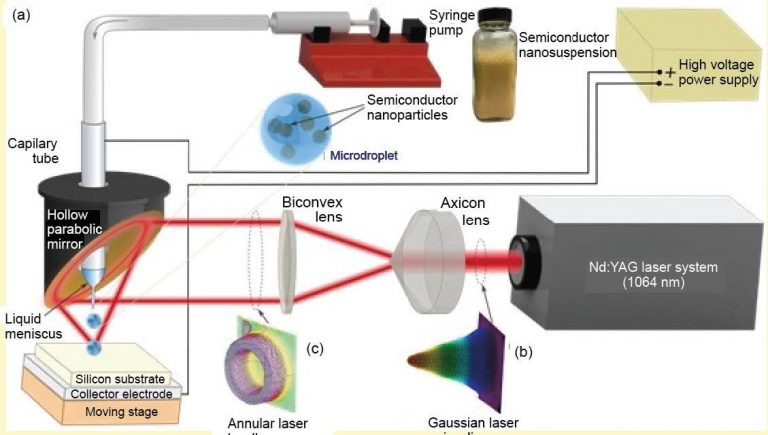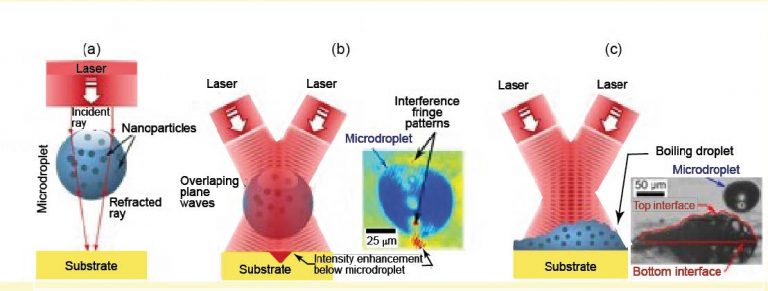Much research has been carried out to produce nanoparticles of various materials due to their excellent mechanical, chemical, electrical, and optical properties. However, it is difficult to deposit and transform nanoparticles into large two-dimensional and three-dimensional structures, such as thin films or discrete arrays of nanodots, in a controlled manner. Recently subwavelength phenomena have drawn considerable interest in developing innovative laser-material interactions to harness the novel properties of nanostructures by depositing nanoparticles in various patterns on rigid or flexible substrates. An interdisciplinary mechanism involving laser-microdroplet interactions yields a new paradigm for next generation nanomanufacturing technology. The novelty lies in the dual role of each microdroplet that carries nanoparticles to the substrate surface and simultaneously acts as a superlens to focus a laser beam to a subwavelength diameter. The laser-microdroplet interaction is achieved by injecting the microdroplets into a conical hollow laser beam so that they meet the laser beam immediately above the substrate surface as illustrated in Fig. 1.
This figure also shows that microdroplets are produced at the tip of a capillary tube from an aqueous suspension of different materials, such as germanium or silicon nanoparticles, by an electrospray process. Professor Aravinda Ranganathan Kar and Kumar observed a new microdripping mode for generating the microdroplets and this mode enabled repeatable deposition of nanoparticles. An axicon lens and a biconvex lens are used to shape a Nd:YAG Gaussian laser of wavelength λ = 1064 nm into an annular beam of nearly uniform radial irradiance distribution. A special hollow parabolic mirror is used to focus the annular laser beam while microdroplets are injected into the hollow beam through the hole in the mirror. The laser beam is focused by the mirror to form a hollow laser cone and refocused by the microdroplet superlens during the laser-droplet interactions in the vicinity of the apex of the cone near the substrate surface. Laser heating of the droplets evaporates the water and sinters the nanoparticles to form microlayers on the substrate. The laser-droplet interactions can be implemented for depositing thin films, lines and regular arrays of microdots as well as nanodots. This process is versatile, efficient, scalable, and provides a convenient method for advanced manufacturing using nanoparticles.

Various stages of the laser-droplet interaction are illustrated in Fig. 2. The evaporation of water provides a cooling mechanism to enable deposition of thin films on flexible substrates such as papers and plastics. The laser-droplet interaction mechanism is envisaged to evolve further to fabricate nanopatterns for wide spread applications including conformal solar cells and ultraflexible electrodes in biological implants. This technology is readily amenable to roll-to-roll manufacturing of optoelectronic components, sensors, actuators, and ultra-flexible electrodes for neuro-stimulators and prosthetics. In addition, microdroplets of pure water containing no nanoparticles can be utilized for nanomachining applications to produce subwavelength (λ/10) structures in substrates.

